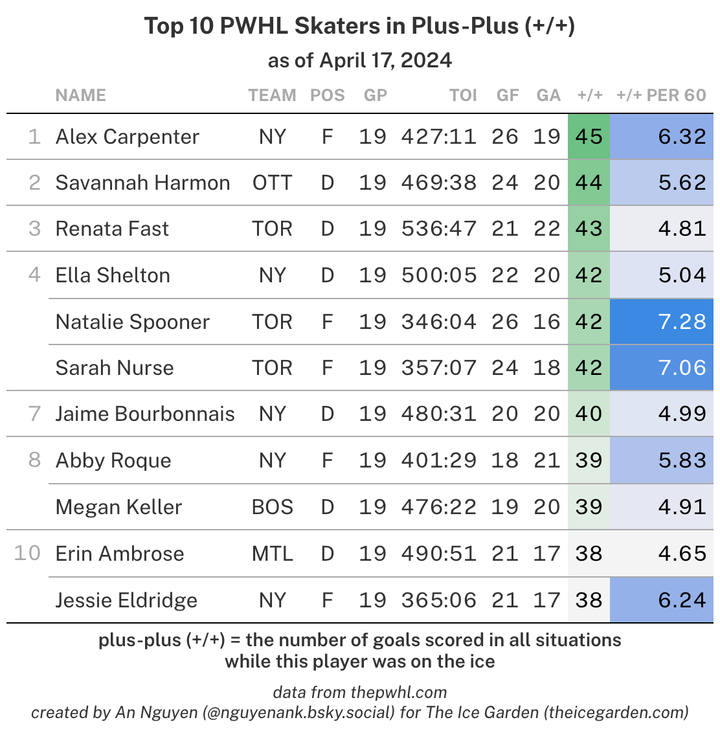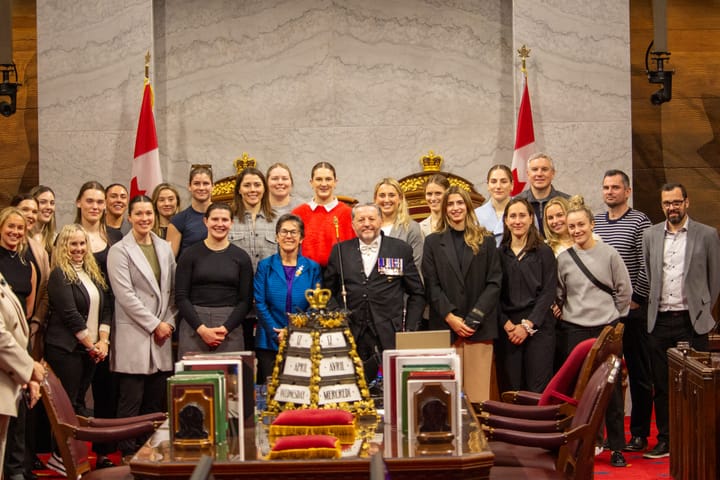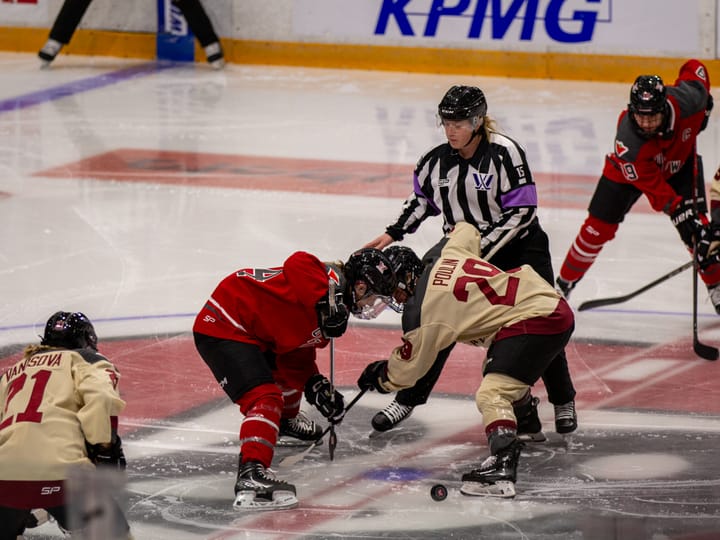Q&A with Sami Jo Small on ‘The Role I Played’
This week, Sami Jo Small released her first book, ‘The Role I Played.’ In it, she looks back at her years on Team Canada, telling behind the scenes stories and giving a raw and honest glimpse into what her life was like through three Olympic cycles.
Small sat down to talk to The Ice Garden about the process of writing the book, important sections to her, and more.
The Ice Garden (TIG): One of the most compelling parts of this book is how raw and honest you are about your feelings when you’re told you’re not starting and when you’re told that you’re the third goaltender and won’t see the ice. How important was it to share those emotions?
Sami Jo Small (SJS): To me, that was really everything.
A book was sort of the next step [as a professional speaker]. I thought I would have it done within a year. I didn’t know what the theme should be, but I thought it would kind of go along with my speech. As I was writing it, I realized this was a moment in history that really had never been told. People obviously knew the outcomes of the games, but they didn’t really know the people. I was writing about my teammates and myself. I found myself realizing that I was a caretaker of this history.
I wanted to treat it and the characters in that situation with the utmost respect and not falsify the feelings because they were real and that’s what you feel at that moment. I could have written it saying ‘I was told I was a backup and I just supported the other goalie and that’s what you should do in life too.’ But that’s not the reality.
When I speak, that to me is what resonates most with people in the audience, the realness in those moments and they feel like they can evoke moments in their lives similar to that. I certainly tried to put myself in every story as if I was there living it. That’s what people connect with. That’s more real, and that’s the reality of putting women on a hockey team. Everybody is feeling different emotions at different times, and that translates into every walk of life as well.
We can’t treat people or judge people, because we don’t know what they’re going through. We don’t know what’s going on in their head or the feelings that they’re having and the situations that they’re in. I think it just reminded me that kindness and empathy is huge, and people had a lot of that for me.
TIG: I feel like you don’t see a lot of hockey players being true to that emotion of what it’s like to be sad or be told that you’re not going to play, like you said they always try to be the team player. So I thought that was super powerful to read how you are open and aware and free with your emotions and your feelings and those moments.
SJS: It’s not easy to write because you are making yourself vulnerable. You’re perhaps saying things that should be kept in your head at times, but I made sure that once the book was written I sent it to both the national team coaches, Danièle Sauvageau and Mel Davison, and to my goalie partners as well. They are the ones that maybe aren’t seen in the best light at times. I wanted them to know just how much I respect and admire them, because that was a feeling at the moment, that wasn’t my feeling in the end when you learn the lesson.
So I wanted to make sure it was okay with them because it was real and it was honest. But you also don’t want other people to feel bad about the situation. All these years later I hope that I have come full circle and showed that as well as the utmost respect I had for them.
Related
‘The Role I Played’ chronicles Sami Jo Small’s career with Team Canada
TIG: You said you consider yourself to be a caretaker of these stories of women’s hockey history. How important to you was it to get in so many names, especially names that people might not know?
SJS: Initially there was even more! But, that was huge for me. We all have our group of friends, but there’s more than just that. I really tried to not just name a person in a situation but also tell a little tidbit about them that maybe most people don’t know.
It’s been interesting now reconnecting with so many of those people through this book, finding out where they are now, what they’re doing now, and what they’re up to. We don’t often get a chance to see each other. I see the ones that are in the GTA and that I’m close to but there’s another 120 women on each of those Olympic teams and then beyond that people that were in the tryout phase that were with us along the way.
I want readers to know that history. While people like Hayley Wickenheiser and Cassie Campbell are the stars and everybody knows them, there was another 100 girls that created that history as well.
I selfishly also wanted to honor those people that meant so much to me in my life. You’re with these people on a constant basis, a daily basis. They do have an influence and I’m just super proud of what they do and where they are. Lots made the team and lots didn’t, but that doesn’t mean that the work and the effort that they put in was all for not. I want them to know the influence that they had.
Related
Book Excerpt: The Role I Played by Sami Jo Small
TIG: I think this is going to be a great testament to women’s hockey history, and just getting more people’s names out there.
SJS: I hope so. Somebody the other day told me that this is — I think it was somebody during an interview — that this is going to be the historical reference for a long time.
TIG: It’s definitely going to be a historical reference. There are so many names I hadn’t heard before.
SJS: Right. There’s even names when I was going back over game tape of international players that I might not have known really. I knew them all, but I might not have included them had I not looked at game tape and looked at notes and what the game records and know who played where. Because we had club hockey and we had Nationals, we had all these sort of various different things but it’s all the same people. So figuring out where everybody fit in and when they played was really exciting for me that was something that was really intriguing, as a sort of fact researcher, that was really neat.
#FF Some incredible international women's hockey stars/coaches that you should follow and are mentioned in my new #book #TheRoleIPlayed @tpuputti @KimMartin86 @ErikaHolst @elanderp @PernillaWinberg If you find any others with twitter from this era, please add their handles. pic.twitter.com/Ld2rYSWbJM
— Sami Jo Small (@SamiJoSmall) September 25, 2020
TIG: Your book is full of details details about your own life and details about games. So how much game footage did you watch to write this or what was your process like?
SJS: I don’t have a great memory for details, but I certainly have a good memory for feelings. I would write a certain segment and then go back to either box scores or game tape and realize that’s not how it happened. It might have been a game that I thought happened two years earlier, it might have been two years later in a different Olympic cycle. It really allowed me sort of a cathartic experience as well to see the trajectory.
But then, I tried, as much as I could, to watch as many games tapes as possible. My mom, being in Winnipeg, videotaped every game for me on VHS. I had them initially when I first started writing after the Vancouver Olympics, like 50-60 videotapes that included multiple games. It was really fun to go back over and watch the game to see what we look like and what we’re doing and the crowds and all that. That was really exciting to me.
I watched countless games, but they weren’t all videotaped. A lot of the games that I played internationally were over in Europe, so I had to trust my instincts in terms of what I was feeling in those moments. Then I could reference the box scores to kind of figure out when it happened.
We also, with Team Canada, had to keep logbooks. We hated doing them at the time, but they served as great reference material for me. After each game, I would document how each goal went in. Maybe that’s not a very positive as a goaltender, but for me it was a learning tool. It served as great fodder for information for the book, to be able to really describe whether I thought it was a good goal or the way it happened. That helped me a lot too and put everything in the right timeline.
I had diary entries too. I took notes along the way of who I might have been rooming with or various different things that happened. I definitely piecemealed it all together. As I would finish one thing like game tape, I would move on to the next and layer it on top of each other so that it all made sense.
The very final thing was to send it to my teammates to ask them if this happened the way they thought it happened. There was a couple changes that some of my teammates wanted or suggested. But for the most part, most of them were like ‘I have no idea but that sounds good.’
TIG: I have a couple of rapid fire questions for you, if you’re up for it. If you could be goalie partners with any goalie alive or dead who would it be?
SJS: Oh, that’s a tough one. I’m going to take out any goalie partner that I’ve ever had, because I’ve really enjoyed all of them and I don’t want to put one above the other. So let’s leave them out.
I would say Curtis Joseph. I’ve read his book and I’ve met him several times. He’s just fascinating. And then Cathy Phillips, who was the goalie on the 1990 Team Canada when they wore the pink jerseys. She played the World Championship with a brain tumor and had to have it removed after. She was having symptoms, like she was dizzy and prone to blackouts. Anyway, she won the World Championship like that. Pretty fascinating.
TIG: That’s a story that’s lost to history.
SJS: It was quite an amazing story because she didn’t want to tell anybody because she didn’t want to lose her spot.
"Every goalie has their nemeses who they just can’t seem to read. Mine are Dana Antal and Tammy Lee Shewchuk. They just always seem to put the puck past me in practice." #Book #TheRoleIPlayed pic.twitter.com/qGMRogx4Vj
— Sami Jo Small (@SamiJoSmall) September 22, 2020
TIG: Who is the hardest skater you’ve ever faced as a goaltender?
SJS: I just posted this on Twitter the other day. On my own team Dana Antal and Tammy Lee Shewchuk, in practice, could light me up with every shot, and neither one had a phenomenal shot. They just had the ability to pick my pocket every single time and score. On my own team, those two would have been the hardest.
Then playing against, I played a lot against Meghan Agosta. I would say that she scored more hat tricks against me probably than anybody else, and that would have been in club hockey.
Then, internationally, I would say Chrissy Wendell. There’s a lot of great Americans like Jenny Potter. Karen Bye was another one. She’s a very different type of shot, just come down the wing and just put it right through you, and her whole body through you.
TIG: If you could pick any two defenders to be in front of you, who would it be?
SJS: I’m going to go with Cheryl Pounder, as a lifelong friend and teammate, and Delaney Collins. She was always my biggest cheerleader, which I always liked. Everybody always likes when people are nice to you. If I could pick an American, I would have Megan Bozek.
Get your copy!!!! Yes @SamiJoSmall @HockeyCanada @HC_Women @IIHFHockey @hockeynight ❤️🇨🇦🏆 @AllistairMcCaw (great read) pic.twitter.com/YBE06H4iwq
— Delaney Collins (@delaneyc34) September 24, 2020





Comments ()